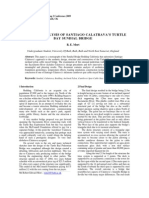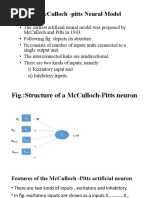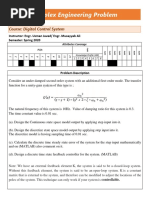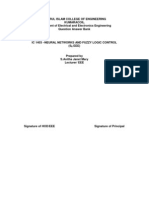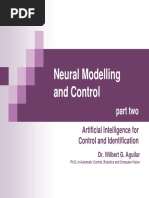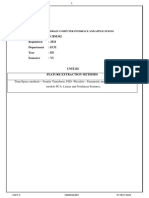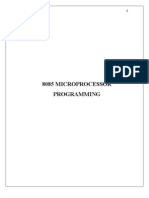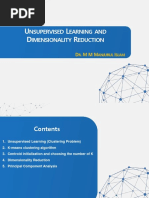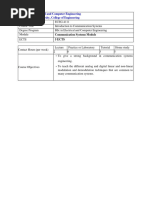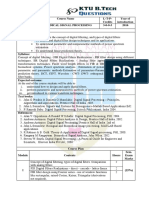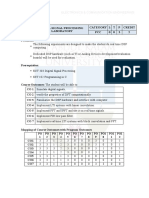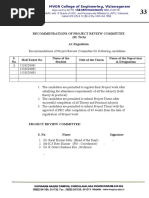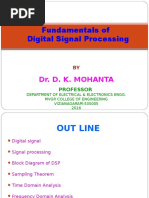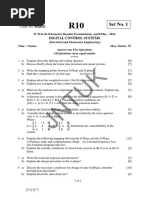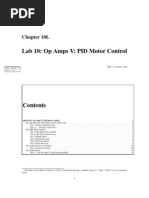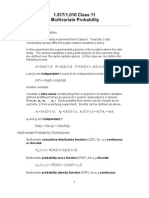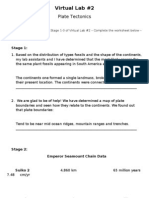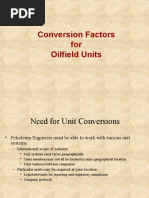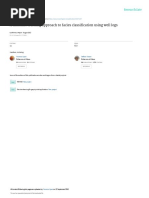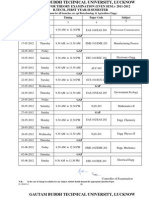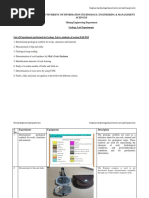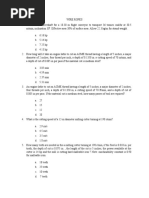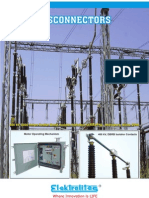MCT Question Bank
MCT Question Bank
Uploaded by
Kalamchety Ravikumar SrinivasaCopyright:
Available Formats
MCT Question Bank
MCT Question Bank
Uploaded by
Kalamchety Ravikumar SrinivasaOriginal Description:
Copyright
Available Formats
Share this document
Did you find this document useful?
Is this content inappropriate?
Copyright:
Available Formats
MCT Question Bank
MCT Question Bank
Uploaded by
Kalamchety Ravikumar SrinivasaCopyright:
Available Formats
MODERN CONTROL THEORY
QUESTION BANK
UNIT-I:
NORMAL
1.
2.
3.
4.
5.
6.
7.
8.
9.
Explain the design procedure for P-controller.
Explain the design procedure for PI-controller.
Explain the design procedure for PID-controller.
Draw electrical network configuration for phase-lead compensator and hence
derive the transfer function for the same.
Draw electrical network configuration for phase-lag compensator and hence
derive the transfer function for the same.
Draw electrical network configuration for phase lag-lead compensator and
hence derive the transfer function for the same.
Explain the procedural steps to design a phase lead compensator in
frequency domain.
Explain the procedural steps to design a phase lag compensator in frequency
domain.
Explain the design procedure for lag- lead compensation in frequency
domain.
APPLICATION
10.The open loop Transfer function of certain unity feedback control system is
given by G(S) = K/S(S+4) (S+80). It is desired to have the phase margin to be
atleast 33 degrees and velocity error constant, K V =30. Design a phase lag
series compensator.
11.Design a lead compensator for a unity feedback system with open loop
transfer function, G(S) =K/S(S+1) (S+5) to satisfy the following specifications
(i) Velocity error constant, KV>=50 (ii) Phase margin is >= 20.
CHALLENGING
12.Consider a unity feedback system with open loop transfer function, G(s) =
100/(s+1) (s+2) (s+3). Design a PID Controller, so that the phase margin of
the system is 45 degrees at a frequency of 4rad/sec and steady state error
for unit ramp input is 0.1.
UNIT 2
NORMAL
1. (a)Define controllability and observability. Give the Kalman's Test for both of them.
(b) Test controllability and observability for the following system.
] []
0 1
0
0
A= 0 0
;
B=
1
0 ; C=[ 1 0 0 ]
0 2 3
1
2.
Use controllability and observability matrices to determine whether the system
represented by the flow graph shown in fig 1. is completely controllable and completely
observable
-1
2
x
2
1 /s
-2
1 /s
-2
1
1
3. (a)Explain the observability test for continuous time invariant sytems?
(b)Consider the system defined by
[][
][ ] [ ]
x1 1 2 2 x 1 2
x2 = 0 1 1 x 2 + 0 u ( t ) ;
1
0 1 x 3 1
x3
[]
x1
z ( t )= [ 1 1 0 ] x 2
x3
Is the system completely state controllable and completely observable?
(b) Determine controllability and observability of the system described by
[][
][ ] [ ]
x1
0
1
0 x1 0
x2 = 0
0
1 x2 + 0 u ;
x3 6 11 6 x 3 1
1 /s
[]
x1
y=[ 4 5 1 ] x 2
x3
4. Explain the concept of Controllability and observability, with the condition for complete
controllability and observability in the S- plane
6.
Check the controllability of the system
] []
1 1 ( ) 1
X ( t )=
X t + U (t )
0 2
0
7. (a)Define controllability and observability. Give the Kalman's Test for both of
(b) Check the controllability of the system by Kalman's method
y +3 y + 2 y =u +u
APPLICATION
8. a) Test the observability using Kalman's method
x ( t )= 2 0 x ( t ) + 3 u ( t ) ; y ( t )=[ 1 0 ] x (t)
0 1
1
] []
(b) Consider the system given by
[][
][ ] [ ]
x1
0
1
0 x1
1 0
x2 = 0
0
1 x2 + 0 1 u ( t ) ;
2
4
3
x3
x 3 1 1
[]
x1
0
1
1
z ( t )=
x2
1 2 1
x3
Check for controllability and observability of the above system.
them.
9.
(a) State the duality between controllability and observability.
(b) A Linear dynamical time invariant system represented by
X =AX + BU
] [ ]
0 1
0
0 1
A= 0 0
1 ; B= 0 0
0 2 3
1 0
Find if system is completely controllable.
CHALLENGING
10. A Linear dynamical time invariant system represented by
0
1
A=
0
0
0
1
0
2
1
3
0 21
Find the matrix
0
0
X =AX + BU
][]
1
0
; B=
0
0
5
0
K R2 X 4
0
0
0
1
for state feedback controller design using pole placement
technique, so that closed loop poles are located at -2,-3+j,-3-j,-4.
UNIT 3
NORMAL
1. Explain saturation and backlash non linearity with necessary diagram
2. Derive the describing function for dead zone and saturation non linearity. Then
find out describing function for only saturation.
3 Describe how stability of the nonlinear system is analyzed using Describing
function method.
4. Derive the describing function of relay with hysteresis nonlinearity.
5. Derive the Describing function of saturation nonlinearity
6. Derive the Describing function for relay nonlinearity.
7. Derive the Describing function for relay with dead zone nonlinearity.
APPLICATION
8. Derive the Describing function for hysteresis nonlinearity.
9. What are the basic components of nonlinear control system block diagram
.Explain the
CHALLENGING
10. What are the standard tests signals employed for time domain studies and
explain those signals?
You might also like
- Sundial Bridge AnalysisDocument10 pagesSundial Bridge Analysiss4120146No ratings yet
- Exercises AnalysismethodsDocument12 pagesExercises AnalysismethodsMaan Hinolan50% (2)
- Linear Control System Lab: Utilizing Simulink To Implement The Mathematical Model of Translational Mechanical SystemDocument8 pagesLinear Control System Lab: Utilizing Simulink To Implement The Mathematical Model of Translational Mechanical SystemMuhammad Saad AbdullahNo ratings yet
- Mcculloch-Pitts Neural Model and Pattern Classification.Document13 pagesMcculloch-Pitts Neural Model and Pattern Classification.MercyNo ratings yet
- Unit-5 Part C 1) Explain The Q Function and Q Learning Algorithm Assuming Deterministic Rewards and Actions With Example. Ans)Document11 pagesUnit-5 Part C 1) Explain The Q Function and Q Learning Algorithm Assuming Deterministic Rewards and Actions With Example. Ans)QUARREL CREATIONSNo ratings yet
- Dica Question BankDocument4 pagesDica Question BankOmprakash KuswahaNo ratings yet
- Complex Engineering Problem DCS 2020Document1 pageComplex Engineering Problem DCS 2020tasibkhanNo ratings yet
- CH - 12 MACDocument55 pagesCH - 12 MACsonyNo ratings yet
- NCIIT 12 ProceedingsDocument86 pagesNCIIT 12 ProceedingsBritto Ebrington Ajay100% (1)
- DSP Chapter 2 Part 1Document45 pagesDSP Chapter 2 Part 1api-26581966100% (1)
- Neural Network Two Mark Q.BDocument19 pagesNeural Network Two Mark Q.BMohanvel2106No ratings yet
- Sample Exam Questions With AnswersDocument5 pagesSample Exam Questions With AnswersMauricio PresotoNo ratings yet
- Expt 3 Generation of Continous Signal CañeteDocument4 pagesExpt 3 Generation of Continous Signal CañeteJHUSTINE CAÑETENo ratings yet
- Neurofuzzy ControllerDocument15 pagesNeurofuzzy ControllerFredy Giovany Osorio GutiérrezNo ratings yet
- Systems For Digital Signal Processing: 1 - IntroductionDocument21 pagesSystems For Digital Signal Processing: 1 - IntroductionBomber KillerNo ratings yet
- Advanced DSPDocument2 pagesAdvanced DSPAshar Wahid Hashmi50% (2)
- Ec8552-Cao Unit 5Document72 pagesEc8552-Cao Unit 5Anonymous c75J3yX33No ratings yet
- Robot DH FKSDocument38 pagesRobot DH FKSengrodeNo ratings yet
- Final Exam - High VoltageDocument5 pagesFinal Exam - High VoltageAdel El-NahasNo ratings yet
- Ad Hoc and Wireless Sensor Networks - Ec8702: Session byDocument28 pagesAd Hoc and Wireless Sensor Networks - Ec8702: Session byRaja MadhuvanthiNo ratings yet
- Jntuh Previous Year PaperDocument2 pagesJntuh Previous Year Paper20BA693 Kmit0% (1)
- Digital Transmission TechniquesDocument85 pagesDigital Transmission TechniquesTafadzwa MurwiraNo ratings yet
- Assignment 3Document19 pagesAssignment 3Sure AvinashNo ratings yet
- Assignments - NOC - MATLAB Programming For Numerical ComputationDocument9 pagesAssignments - NOC - MATLAB Programming For Numerical ComputationPraghashrajaNo ratings yet
- Evaluation Metrics For Regression: Dr. Jasmeet Singh Assistant Professor, Csed Tiet, PatialaDocument13 pagesEvaluation Metrics For Regression: Dr. Jasmeet Singh Assistant Professor, Csed Tiet, PatialaDhananjay ChhabraNo ratings yet
- 9 - Neural Modelling and ControlDocument17 pages9 - Neural Modelling and ControlIsmael EspinozaNo ratings yet
- Multirate Signal Processing 1.4Document45 pagesMultirate Signal Processing 1.4criharshaNo ratings yet
- Microcontroller and PLCDocument3 pagesMicrocontroller and PLCsivaeeinfo0% (1)
- Signals Systems Question PaperDocument14 pagesSignals Systems Question PaperCoeus Apollo100% (1)
- Bci Unit 3Document28 pagesBci Unit 3personaluses3289No ratings yet
- EE 340: Control Systems Lab 4 Manual Introduction To SimulinkDocument13 pagesEE 340: Control Systems Lab 4 Manual Introduction To SimulinkAnsar NiaziNo ratings yet
- 3 - ANN Part One PDFDocument30 pages3 - ANN Part One PDFIsmael EspinozaNo ratings yet
- MPMC Lab Manual To PrintDocument138 pagesMPMC Lab Manual To PrintKasthuri SelvamNo ratings yet
- Aim: To Convert CD To DVD Data Software: Matlab 2013A TheoryDocument2 pagesAim: To Convert CD To DVD Data Software: Matlab 2013A TheoryHabeeb AliNo ratings yet
- Experiment No. 2 Control System Simulation Using MATLAB and SIMULINKDocument11 pagesExperiment No. 2 Control System Simulation Using MATLAB and SIMULINKSom Pratap SinghNo ratings yet
- تشييكDocument30 pagesتشييكAbdullah zxNo ratings yet
- Experiment - 6 Four-Quadrant Operation of DC MotorDocument12 pagesExperiment - 6 Four-Quadrant Operation of DC Motoreng_abdelghany1979No ratings yet
- U L D R: Nsupervised Earning and Imensionality EductionDocument58 pagesU L D R: Nsupervised Earning and Imensionality EductionSanaullahSunnyNo ratings yet
- Modern Control Systems (MCS) : Lecture-41-42 Design of Control Systems in Sate SpaceDocument21 pagesModern Control Systems (MCS) : Lecture-41-42 Design of Control Systems in Sate SpaceVeena Divya KrishnappaNo ratings yet
- Cellular and Mobile Communications: Subject Code: A70434 Ece - Iv-I Sem Jntuh-R15Document306 pagesCellular and Mobile Communications: Subject Code: A70434 Ece - Iv-I Sem Jntuh-R15YashwantSaiKishoreNo ratings yet
- Introduction To Communication System Course OutlineDocument3 pagesIntroduction To Communication System Course OutlineBirhanu MelsNo ratings yet
- Embedded Systems SRSDocument4 pagesEmbedded Systems SRSkingloky100% (1)
- ADHOC UNIT-1 Applications PDFDocument32 pagesADHOC UNIT-1 Applications PDFNithish Kumar0% (1)
- Tutorial I Basics of State Variable ModelingDocument11 pagesTutorial I Basics of State Variable ModelingRebecca GrayNo ratings yet
- Discrete-Time Signals and Systems - GDLCDocument111 pagesDiscrete-Time Signals and Systems - GDLCRavi BankNo ratings yet
- Lab 3 QUBE-Servo First Principles Modeling Workbook (Student)Document6 pagesLab 3 QUBE-Servo First Principles Modeling Workbook (Student)Luis EnriquezNo ratings yet
- Lab Requirements Ece University Inspection Reg 2017Document12 pagesLab Requirements Ece University Inspection Reg 2017sukirthanrajasreesweNo ratings yet
- Content Beyond SyllabusDocument3 pagesContent Beyond SyllabusSasithar JaisankaranNo ratings yet
- Unit V Peripheral InterfacingDocument38 pagesUnit V Peripheral Interfacingsuperkan61950% (2)
- Full State Feedback ControlDocument8 pagesFull State Feedback ControlGabriel RodriguesNo ratings yet
- Lesson Plan - Signals & Systems 2012Document3 pagesLesson Plan - Signals & Systems 2012KALAIMATHINo ratings yet
- Iare Ece Vi-Emi Emi-Lecture Notes-Word NewDocument185 pagesIare Ece Vi-Emi Emi-Lecture Notes-Word NewSiva KumarNo ratings yet
- JNTUH Signals and Systems NotesDocument67 pagesJNTUH Signals and Systems Notesq1213jNo ratings yet
- BM304 Biomedical Signal Processing PDFDocument2 pagesBM304 Biomedical Signal Processing PDFsethuNo ratings yet
- ECE4007 Information-Theory-And-Coding ETH 1 AC40Document3 pagesECE4007 Information-Theory-And-Coding ETH 1 AC40harshitNo ratings yet
- Exam2005 2Document19 pagesExam2005 2kib67070% (1)
- Channel Assignment Strategies, Handoff Strategies Improvement inDocument37 pagesChannel Assignment Strategies, Handoff Strategies Improvement inHarpuneet SinghNo ratings yet
- ECL333 - Ktu QbankDocument7 pagesECL333 - Ktu QbankRoshith KNo ratings yet
- R07 Set No. 2Document8 pagesR07 Set No. 2chenumallaNo ratings yet
- 4364 540 DigitalControlDocument2 pages4364 540 DigitalControlyogesh_b_kNo ratings yet
- Control SystemsDocument8 pagesControl Systemsvasantha_btechNo ratings yet
- Microstructure, Mechanical Properties and Non-Destructive Test On Dissimilar AA5083-AA7075 Aluminium Alloys Using GTAWDocument14 pagesMicrostructure, Mechanical Properties and Non-Destructive Test On Dissimilar AA5083-AA7075 Aluminium Alloys Using GTAWKalamchety Ravikumar SrinivasaNo ratings yet
- Batch5supercapacitor 150808131503 Lva1 App6892Document54 pagesBatch5supercapacitor 150808131503 Lva1 App6892Kalamchety Ravikumar SrinivasaNo ratings yet
- 2017-2019 Batch PanelDocument2 pages2017-2019 Batch PanelKalamchety Ravikumar SrinivasaNo ratings yet
- RECOMMENDATIONS OF PROJECT REVIEW COMMITTEE Format EeeDocument1 pageRECOMMENDATIONS OF PROJECT REVIEW COMMITTEE Format EeeKalamchety Ravikumar SrinivasaNo ratings yet
- Students Details Sar 2016-17Document39 pagesStudents Details Sar 2016-17Kalamchety Ravikumar SrinivasaNo ratings yet
- SION InHouse Product DevelopmentsDocument1 pageSION InHouse Product DevelopmentsKalamchety Ravikumar SrinivasaNo ratings yet
- Fundamentals of Digital Signal Processing: Dr. D. K. MohantaDocument48 pagesFundamentals of Digital Signal Processing: Dr. D. K. MohantaKalamchety Ravikumar Srinivasa100% (1)
- Digital Control Systems - 2Document5 pagesDigital Control Systems - 2Kalamchety Ravikumar SrinivasaNo ratings yet
- Es Transforum 10-3Document24 pagesEs Transforum 10-3Kalamchety Ravikumar SrinivasaNo ratings yet
- A Bellman-Ford Approach To Energy Efficient Routing of EvDocument4 pagesA Bellman-Ford Approach To Energy Efficient Routing of EvKalamchety Ravikumar SrinivasaNo ratings yet
- Dr. R. Gowri Sankara Rao: Professor and Head of The Dept. Dept. of EEE MVGR College of Engineering, VizianagaramDocument17 pagesDr. R. Gowri Sankara Rao: Professor and Head of The Dept. Dept. of EEE MVGR College of Engineering, VizianagaramKalamchety Ravikumar SrinivasaNo ratings yet
- Lab Op5 Pid Oct10Document15 pagesLab Op5 Pid Oct10Kalamchety Ravikumar SrinivasaNo ratings yet
- FT110 FT210Document2 pagesFT110 FT210mikadahlNo ratings yet
- 1.017/1.010 Class 11 Multivariate Probability: Multiple Random VariablesDocument3 pages1.017/1.010 Class 11 Multivariate Probability: Multiple Random VariablesDr. Ir. R. Didin Kusdian, MT.No ratings yet
- Study of Rayleigh-B Enard-Brinkman Convection Using LTNE Model and Coupled, Real Ginzburg-Landau EquationsDocument8 pagesStudy of Rayleigh-B Enard-Brinkman Convection Using LTNE Model and Coupled, Real Ginzburg-Landau EquationsDebuNo ratings yet
- Compositional Analysis of Foods - Food Analysis - S.S. NielsenDocument2 pagesCompositional Analysis of Foods - Food Analysis - S.S. NielsenSyed Asim BachaNo ratings yet
- Test Schedule Summary.1709Document116 pagesTest Schedule Summary.1709Sharath ChandraNo ratings yet
- 066 LW Tensile Tester v2.0 PDFDocument4 pages066 LW Tensile Tester v2.0 PDFMarkusNo ratings yet
- 6.water Treatment and Make-Up Water SystemDocument18 pages6.water Treatment and Make-Up Water Systempepenapao1217100% (1)
- Automatic Sorting Machine Using Conveyor Belt: June 2015Document6 pagesAutomatic Sorting Machine Using Conveyor Belt: June 2015Vikashini GNo ratings yet
- Lecture Notes-1 - Physical and Mechanical Properties of Materials-2020Document11 pagesLecture Notes-1 - Physical and Mechanical Properties of Materials-2020Jesh KeerawellaNo ratings yet
- Effect of Core Materials On Stress Distribution of PostsDocument5 pagesEffect of Core Materials On Stress Distribution of PostsVikas DeepNo ratings yet
- Virtual Lab #2Document3 pagesVirtual Lab #2yumnakhalil11111No ratings yet
- Demagnetizing A Tape RecorderDocument3 pagesDemagnetizing A Tape RecorderSzilvester SzilvesterNo ratings yet
- Conversion Factors For Oilfield UnitsDocument12 pagesConversion Factors For Oilfield UnitsAfzal AktharNo ratings yet
- Asme B31.4Document130 pagesAsme B31.4chavico113No ratings yet
- Kemrex Pile Calculation: Hmc-Pp4 ProjectDocument15 pagesKemrex Pile Calculation: Hmc-Pp4 ProjectSurat WaritNo ratings yet
- Symmetry Relationships Between Crystal StructuresDocument349 pagesSymmetry Relationships Between Crystal StructuresRocio Iribarren VargasNo ratings yet
- Dynamic Stability of Thin-Walled Structures: A Semi-AnalyticalDocument244 pagesDynamic Stability of Thin-Walled Structures: A Semi-Analyticalnjm00175% (4)
- 05 Task Performance 1Document3 pages05 Task Performance 1human beingNo ratings yet
- A Machine Learning Approach To Facies Classification Using Well LogsDocument6 pagesA Machine Learning Approach To Facies Classification Using Well Logsherdissam1No ratings yet
- Schedule For Theory Examination (Even Sem.) - 2011-2012 B.Tech., First Year-Ii SemesterDocument66 pagesSchedule For Theory Examination (Even Sem.) - 2011-2012 B.Tech., First Year-Ii SemesterSheetal P. ManiNo ratings yet
- Learning GoalsDocument15 pagesLearning GoalsIir Mnemonis0% (7)
- Geology Lab 1Document5 pagesGeology Lab 1TufailAhmadNo ratings yet
- ProCam XL User Guide EnglishDocument17 pagesProCam XL User Guide EnglishApolloGRNo ratings yet
- Wire RopesDocument4 pagesWire RopesEjNo ratings yet
- E-Catalog For Butyl Adhesive Waterproof Tape SaDocument10 pagesE-Catalog For Butyl Adhesive Waterproof Tape SaVasilis EvangelidisNo ratings yet
- Dis ConnectorsDocument4 pagesDis ConnectorssaravanakumartbNo ratings yet
- Precious Metals Recovery From Cyanide Solution Using EMEW Technology V3 ...Document18 pagesPrecious Metals Recovery From Cyanide Solution Using EMEW Technology V3 ...Agung W. WidodoNo ratings yet
- Runout Mecanico y ElectricoDocument6 pagesRunout Mecanico y ElectricoJuan Pablo Chumba LaraNo ratings yet
